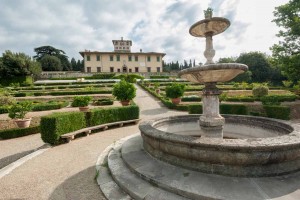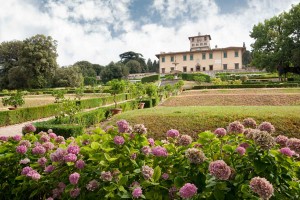Borgia, Este, Sforza, Grimaldi – Italy’s history is also the history of influential families and noble dynasties. They left their marks on cities, even entire areas, and acted as patrons for the fine arts. The Medici most certainly belong on this list. This Florence-based family had great influence from the 15th to the 18th century. Several Grand Dukes of Tuscany, two Queens of France and even popes came from this family. The Medici patronage moulded the Renaissance in Florence and its surroundings. Twelve of their villas and two gardens in Tuscany were declared UNESCO World Heritage Site in 2013. Time for a tour through this stunning region!
Who were the Medici?

©Bigstock.com/zummolo
The family likely originates in the surroundings of Florence with first documentation dating back to the second half of the 13th century. They belonged to the guild of merchants and were civic patricians. Salvestro de’ Medici was the first of the family to gain power about 100 years later, but his dictatorial manner got him banished quickly. The establishment of Banco Medici brought prestige, standing and wealth to the family. Cosimo de’ Medici, “Il Vecchio” (“The Elder”), would decisively contribute to the rise of Florence through his patronage of the arts and education.
The Medici reigned over Florence until 1537 with two disruptions before the city became part of the Grand Duchy of Tuscany. Cosimo I was declared Grand Duke of Tuscany setting the stage for another successful line of rulers. It only ceased to exist in 1737 when the childless Grand Duke Gian Gastone died, and the duchy was given to Francis I of Lorraine. There are still living descendants with the famous name including Italian author Lorenzo de’ Medici. He wrote a fascinating family biography and hosted a five-part documentary series about his family’s palaces.
The Medici gardens

©Bigstock.com/zummolo
Here’s the big question surrounding this massive UNESCO World Heritage Site: Where on earth should you start? We’ll kick things off by taking you to the two gardens in and around Florence. The Boboli Gardens are behind Palazzo Pitti, the former home of the Medici. It is widely regarded as one of the most famous 16th century Italian gardens with its drawn-out axes, impressive stone elements, the plurality of fountains and statues, and the grottos and nymphs creating a border between the public and semi-private areas. The creation of Eleonora of Toledo – the wife of Cosimo I – has since been turned into a garden sculpture open-air museum of sorts with exhibits dating back to Roman times.
Pratolino, a district of Vaglia, is located a few kilometres outside the city. The amazing park of the Medici villa, also known as Villa Demidoff, unfortunately lost many of its statues over the centuries. Some disappeared completely, others were re-located, e.g. to the Boboli Gardens. Only a few remained, such as the mighty Apennine Colossus by Giambologna. Written works and paintings testify to the former glory of the garden.
The villas in Florence
Now it’s finally time for the villas, and there are a whopping twelve of them, four of which are in Florence. They illustrate the power and wealth of the Medici in many different ways and date back to different eras. Where to go… well, why not to all of them!
- Careggi: Unlike later buildings, the Careggi villa, of the oldest Medici villas, looks fairly rustic. While its appearance carries fortress-like qualities, there’s many a treasure hidden behind the walls. The garden with its geometrical arrangement is a true gem.
- La Petraia: One of the most famous Medici villas was built on the foundations of a Brunelleschi castle toward the end of the 16th You reach the ostentatious manor, which now serves as a museum, by crossing the multi-terraced garden that was incorporated into an English landscape garden during Lorrain reign.
- Castello: In all fairness, the villa amidst the rolling hills of Florence is not that important at all. The spectacular main event, however, is the garden behind it. It is widely regarded as being the best-preserved ideal of Leon Battista Alberti’s Italian garden with three terraces and compact, geometrical form. Don’t miss out on the magical animal grotto!
- Poggio Imperiale: Ready for another trip to the hills? This multi-time altered building rises near the panoramic road Viale dei Colli. Magnificent frescoes by Matteo Rosselli and his students depict the close relationship to the House of Austria. The villa is now used as a school.
Other World Heritage villas of the Medici
That was just the beginning – we have another eight Medici villas waiting for you! Their location is mostly of strategic nature planned to protect hunting grounds and valuable sources of income. However, fine arts and summer resorts played a key role as well.
- Cerreto Guidi: This amazing hunting seat is situated about halfway between Florence and Lucca. The protected hillside location makes the villa of Cerreto Guidi visible from afar. It currently houses an interesting little hunting museum.
- Fiesole: Unlike many other older Medici villas, the one in Fiesole is still in pretty great shape. The Medici used to relax here and found intellectual stimulation. There’s another fascinating garden with lemon trees behind it. Sightseeing is, however, rather difficult, as the villa is privately owned.
- Poggio: The former Medici summer resort has been turned into one massive museum. Here you can experience frescoes, musical instruments and other items from the life and rule of the family. However, little remains of the former decoration. Instead, the spectacular architecture – Poggio is likely the first manorial villa of the Renaissance – impresses quite a bit.
- La Magia: This building in the heart of Quarrata is rather small but nice. Grand Duke Francesco I bought La Magia in 1583 to extend his hunting grounds. Now owned by the municipality, the villa has a rather simple and clean look including an inviting garden.
- Artimino: This villa on the ridge of Monte Albano features no garden whatsoever due to lack of water in this mountainous region. Instead, a lot of heart and dedication was put into this building, currently serving as an event venue to rent, with many restorations allowing it to retains its original charm.
- Cafaggiolo: This former castle was already owned by the family in the early 15th century before its conversion into a still rather fortress-like villa a few decades later. Unfortunately, the Borghese had the walls and towers torn down in the 19th The Renaissance garden was lost along the way as well.
- Trebbio: Visits of this early Medici villas are a rarity due to private ownership. If you get the chance, go for it! This particularly old building with its truly tremendous terrace garden still impresses to this very day.
- Seravezza: Several paintings, such as the one by Giusto Utens, adumbrate the former charm of this villa in the Province of Lucca. The Seravezza location allowed Cosimo I to secure his claim to the marble quarries, the silver and lead mines. As such, the building was mostly a means to an end. The old garden sadly disappeared.
There’s a lot of work waiting for you if you really want to visit all Medici gardens and villas. It is most certainly worth the effort as you get to see exciting buildings, amazing gardens, wonderful cities and cute villages in idyllic Tuscany. Enjoy your truly unforgettable journey!